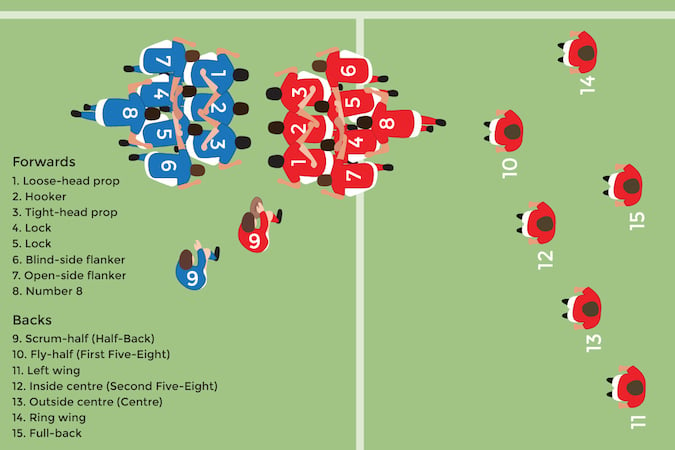Rugby positions: Backs

Image credit: SportSG
Click here to get your tickets to the HSBC Singapore Rugby Sevens!
As one of the sports with the most number of players on a team, rugby requires an array of specialist positions. Here are the positions for the ‘backs’ and the typical roles and responsibilities they each have.
Scrum-half (Half-back)
The link between the forwards and the backs, the scrum-half (no. 9), is an important player when it comes to defending and attacking. Though typically much smaller in physique compared to the forwards, the scrumhalf is in charge of conducting the forward operations, giving instructions to the forward pack on where and what to do. In set plays such as the scrum and lineouts, the scrum-half has the important task of making sure that the fly-half receives clean, quick ball from which to launch attacks.
Fly-half (First five-eight)
Often the best kicker in the team, the fly-half or standoff (no. 10) commands the direction of the game. Since the fly-half is in the middle of all the action, he/she is able to get an overall view of how the match is proceeding, and hence, apart from the team captain, is the most influential on the pitch, making the majority of the tactical decisions.
Centers
The inside center or second five-eight (no.12) and outside center (no.13) make up the midfield pairing in the three-quarters and are traditionally the teams strongest tacklers and runners of the ball. They are the engine of the backline and are tasked with organising the defence in back play while helping to create space and scoring opportunities in attack. An all-rounded skill set is required, as both centers are also required to be good at passing and kicking as well
Wingers
The left wing (no. 11) and right wing (no.14) are positioned in front of the full back on both sides of the scrum. Wingers are traditionally the fastest players on each team, and as such play a big role in attacking where they are usually the ones to finish off the moves by scoring the tries. Swerving, side-stepping and silky running with the ball in order to elude opponents are important skills for wingers along with the ability to field kicks. Together with the fullback the trio are commonly known as the ‘back three’ of each side.
Fullback
The fullback (no.15), especially at set-pieces, is positioned all the way at the back of the team.As he’s able to see the play unfolding, a good fullback needs to have good communication skillsto inform teammates of both potential dangers and opportunities. The fullback, being the last line of defence, has to be defensively strong to make last ditch tackles and field testing highkicks by opponents. His reading of the game has to be good on offence as well as the fullback is expected to join in the attack by acting as a decoy runner, breaking into the opponent’s defensive line and creating space for the wingers.
To receive the latest updates on the happenings in the Singapore sports scene, or to find out more about some of the latest programmes on offer at ActiveSG, like our Facebook page here.





![ActiveSG Academies and Clubs Logo (Solid Colour)[8647]](https://www.activesgcircle.gov.sg/hs-fs/hubfs/ActiveSG%20Circle%202023Theme/images/ActiveSG%20Academies%20and%20Clubs%20Logo%20(Solid%20Colour)%5B8647%5D.png?width=150&height=65&name=ActiveSG%20Academies%20and%20Clubs%20Logo%20(Solid%20Colour)%5B8647%5D.png)



-01.png?width=200&height=141&name=Team%20Singapore%20Logo%20(Red)-01.png)



